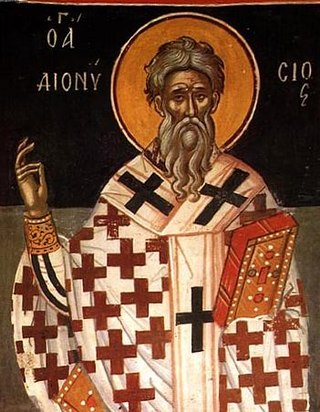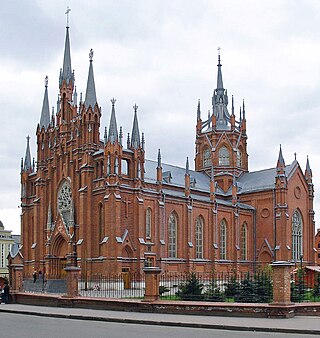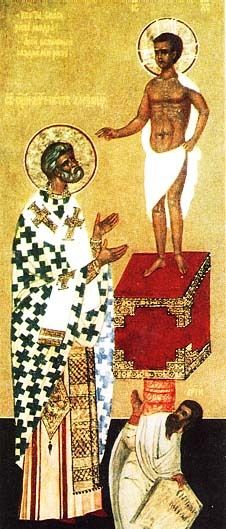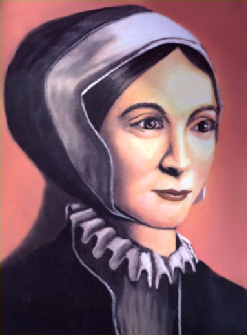Related Research Articles
Pope Marcellus I was the bishop of Rome from May or June 308 to his death. He succeeded Marcellinus after a considerable interval. Under Maxentius, he was banished from Rome in 309, on account of the tumult caused by the severity of the penances he had imposed on Christians who had lapsed under the recent persecution. He died the same year, being succeeded by Eusebius. His relics are under the altar of San Marcello al Corso in Rome. Since 1969 his feast day, traditionally kept on 16 January, is left to local calendars and is no longer inscribed in the General Roman Calendar.
Pope Urban I (175?–230) was the bishop of Rome from 222 to 23 May 230. He was born in Rome and succeeded Callixtus I, who had been martyred. It was previously believed for centuries that Urban I was also martyred. However, recent historical discoveries now lead scholars to believe that he died of natural causes.

Cyprian was a bishop of Carthage and an early Christian writer of Berber descent, many of whose Latin works are extant. He is recognized as a saint in the Western and Eastern churches.

Pope Cornelius was the bishop of Rome from 6th or 13th March 251 until his martyrdom in June 253. He was pope during and following a period of persecution of the church, while a schism occurred over how repentant church members who had practiced pagan sacrifices to protect themselves could be readmitted to the church. He agreed with Cyprian of Carthage that those who had lapsed could be restored to communion after varying forms of Reinitiation and Penance. This position was in contrast to the Novatianists, who held that those who failed to maintain their confession of faith under persecution would not be received again into communion with the church. This resulted in a short-lived schism in the Church of Rome that spread as each side sought to gather support. Cornelius held a synod that confirmed his election and excommunicated Novatian, but the controversy regarding lapsed members continued for years.
Pope Marcellinus was the bishop of Rome from 30 June 296 to his death in 304. A historical accusation was levelled at him by some sources to the effect that he might have renounced Christianity during Emperor Diocletian's persecution of Christians before repenting afterwards, which would explain why he is omitted from lists of martyrs. The accusation is rejected, among others, by Augustine of Hippo. He is today venerated as a saint in the Catholic Church and in the Serbian Orthodox Church.
Pope Felix III was the bishop of Rome from 13 March 483 to his death. His repudiation of the Henotikon is considered the beginning of the Acacian schism. He is commemorated on March 1.
Novatian was a scholar, priest, and theologian. He is considered by the Catholic Church to have been an antipope between 251 and 258. Some Greek authors give his name as Novatus, who was an African presbyter.
The Korean Martyrs were the victims of religious persecution against Catholics during the 19th century in Korea. Between 8,000–10,000 Korean Christians were killed during this period. 103 Catholics were canonised en masse in May 1984, including the first Korean Catholic priest, Andrew Kim Taegon, who was executed by sword in 1846.
Confessor is a title used within Christianity in several ways.

Dionysius the Great was the 14th Pope and Patriarch of Alexandria from 28 December 248 until his death on 22 March 264. Most information known about him comes from his large surviving correspondence. Only one original letter survives to this day; the remaining letters are excerpted in the works of Eusebius.

The Russian Greek Catholic Church, Russian Byzantine Catholic Church or simply Russian Catholic Church, is a sui iuris Byzantine Rite Eastern Catholic jurisdiction of the worldwide Catholic Church. Historically, it represents the first reunion of members of the Russian Orthodox Church with the Catholic Church. It is in full communion with and subject to the authority of the Pope of Rome as defined by Code of Canons of the Eastern Churches.

Irish Catholic Martyrs were 24 Irish men and women who have been beatified or canonized for dying for their Catholic faith between 1537 and 1681 in Ireland. The canonisation of Oliver Plunkett in 1975 brought an awareness of the others who died for the Catholic faith in the 16th and 17th centuries. On 22 September 1992 Pope John Paul II proclaimed a representative group from Ireland as martyrs and beatified them.
During the Spanish Civil War Catholic people faced persecution from the Republican faction of the war, in part due to their support of the nationalists and the recently abolished monarchy. The Catholic Church venerates them as martyrs. More than 6,800 clerics and other Catholic people were killed in what has been dubbed the Red Terror. As of October 2022, 2,107 Spanish martyrs have been beatified; 11 of them being canonized. For some 2,000 additional martyrs, the beatification process is underway

The Martyr Saints of China, or Augustine Zhao Rong and his Companions, are 120 saints of the Catholic Church. The 87 Chinese Catholics and 33 Western missionaries from the mid-17th century to 1930 were martyred because of their ministry and, in some cases, for their refusal to apostatize.
Persecutions against the Catholic Church took place during the papacy of Pope Pius XII (1939–1958). Pius' reign coincided with World War II (1939–1945), followed by the commencement of the Cold War and the accelerating European decolonisation. During his papacy, the Catholic Church faced persecution under Fascist and Communist governments.
Confessor of the Faith is a title given by some Christian denominations.

Pope Peter I of Alexandria was the 17th Pope and Patriarch of Alexandria. He is revered as a saint by the Coptic Orthodox Church, the Eastern Orthodox Church, and the Catholic Church.

Margaret Clitherow was an English saint and martyr of the Roman Catholic Church, known as "the Pearl of York". She was pressed to death for refusing to enter a plea to the charge of harbouring Catholic priests. She was canonised in 1970 by Pope Paul VI.
The Martyrs of Natal were a group of 30 Roman Catholic people of Colonial Brazil – two of them priests – killed in the northern part of the colony in massacres that a large group of Dutch Calvinists led. One priest was a Colonial Brazilian Jesuit missionary, while the other priest was an evangelizer himself. The others were all lay Catholics, most of them anonymous members of the Church, some of them children.

Bishop Iryney Ihor Bilyk, O.S.B.M. is a Ukrainian Greek Catholic hierarch. He served as Auxiliary Bishop of Ukrainian Catholic Eparchy of Ivano-Frankivsk from 15 August 1989 until 21 July 2000, as an Eparchial Bishop of Buchach since from 21 July 2000 until 27 July 2007 and as Canon of Basilica di Santa Maria Maggiore since 27 July 2007.